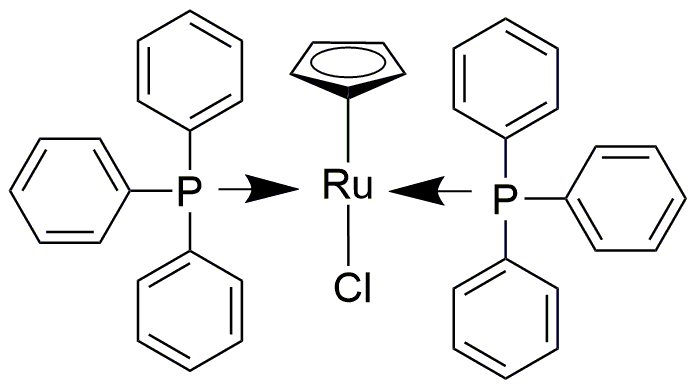Cyclopentadienylbis(triphenylphosphine)ruthenium(II) chloride is widely utilized in research focused on:
- Catalysis: This compound serves as an effective catalyst in various organic reactions, including olefin metathesis, which is crucial in the production of polymers and fine chemicals.
- Materials Science: It is used in the development of advanced materials, particularly in the synthesis of conductive polymers and nanomaterials, enhancing the properties of electronic devices.
- Pharmaceuticals: The compound plays a role in drug development, particularly in the synthesis of complex organic molecules, which can lead to new therapeutic agents.
- Environmental Chemistry: It is applied in processes aimed at pollutant degradation, contributing to the development of greener chemical processes and waste management solutions.
- Research and Development: This chemical is a valuable tool in academic and industrial laboratories for exploring new reaction pathways and improving existing methodologies.
General Information
Properties
Safety and Regulations
Applications
Cyclopentadienylbis(triphenylphosphine)ruthenium(II) chloride is widely utilized in research focused on:
- Catalysis: This compound serves as an effective catalyst in various organic reactions, including olefin metathesis, which is crucial in the production of polymers and fine chemicals.
- Materials Science: It is used in the development of advanced materials, particularly in the synthesis of conductive polymers and nanomaterials, enhancing the properties of electronic devices.
- Pharmaceuticals: The compound plays a role in drug development, particularly in the synthesis of complex organic molecules, which can lead to new therapeutic agents.
- Environmental Chemistry: It is applied in processes aimed at pollutant degradation, contributing to the development of greener chemical processes and waste management solutions.
- Research and Development: This chemical is a valuable tool in academic and industrial laboratories for exploring new reaction pathways and improving existing methodologies.
Documents
Safety Data Sheets (SDS)
The SDS provides comprehensive safety information on handling, storage, and disposal of the product.
Product Specification (PS)
The PS provides a comprehensive breakdown of the product’s properties, including chemical composition, physical state, purity, and storage requirements. It also details acceptable quality ranges and the product's intended applications.
Certificates of Analysis (COA)
Search for Certificates of Analysis (COA) by entering the products Lot Number. Lot and Batch Numbers can be found on a product’s label following the words ‘Lot’ or ‘Batch’.
*Catalog Number
*Lot Number
Certificates Of Origin (COO)
This COO confirms the country where the product was manufactured, and also details the materials and components used in it and whether it is derived from natural, synthetic, or other specific sources. This certificate may be required for customs, trade, and regulatory compliance.
*Catalog Number
*Lot Number
Safety Data Sheets (SDS)
The SDS provides comprehensive safety information on handling, storage, and disposal of the product.
DownloadProduct Specification (PS)
The PS provides a comprehensive breakdown of the product’s properties, including chemical composition, physical state, purity, and storage requirements. It also details acceptable quality ranges and the product's intended applications.
DownloadCertificates of Analysis (COA)
Search for Certificates of Analysis (COA) by entering the products Lot Number. Lot and Batch Numbers can be found on a product’s label following the words ‘Lot’ or ‘Batch’.
*Catalog Number
*Lot Number
Certificates Of Origin (COO)
This COO confirms the country where the product was manufactured, and also details the materials and components used in it and whether it is derived from natural, synthetic, or other specific sources. This certificate may be required for customs, trade, and regulatory compliance.


